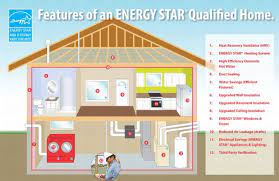Introduction
Water conservation is a crucial aspect of creating a greener and more sustainable home. Implementing water-saving fixtures not only helps reduce water consumption but also contributes to lower utility bills and a more eco-friendly lifestyle. In this article, we’ll explore a variety of water-saving fixtures that you can incorporate into your home for a more sustainable and water-efficient living space.
1. Low-Flow Toilets
Traditional toilets can be major water wasters, using excessive amounts of water with each flush. Low-flow toilets are designed to use significantly less water per flush, typically around 1.6 gallons or even less. Some models also offer dual-flush options, allowing users to choose a lower water volume for liquid waste and a slightly higher volume for solid waste.
2. Water-Saving Showerheads
Upgrading to a water-saving showerhead is a simple and effective way to reduce water usage in the bathroom. These fixtures are designed to maintain a comfortable water pressure while using less water per minute. Some water-saving showerheads use aerating technology, which mixes air with water to create a satisfying shower experience while conserving water.
3. Faucet Aerators
Faucet aerators are small devices that can be easily added to the tip of existing faucets. They work by mixing air with the water stream, maintaining water pressure while reducing the overall flow. Installing faucet aerators is a cost-effective and quick solution to make kitchen and bathroom faucets more water-efficient.
4. Smart Irrigation Systems
Outdoor water usage, particularly for irrigation, can be a significant contributor to residential water consumption. Smart irrigation systems use weather data and soil moisture sensors to optimize watering schedules. They ensure that your lawn and garden receive just the right amount of water, reducing waste and promoting healthier plant growth.
5. Rain Barrels
Collecting rainwater for outdoor use is a sustainable practice that reduces reliance on municipal water supplies. Rain barrels can be connected to downspouts to capture rainwater runoff from the roof. This collected water can then be used for watering plants, gardens, or even for washing outdoor surfaces.
6. Drip Irrigation Systems
Drip irrigation systems deliver water directly to the base of plants, minimizing water loss through evaporation or runoff. These systems use a network of tubing and emitters to provide a slow and steady supply of water to the root zones of plants. Drip irrigation is highly efficient and conserves water in landscaping.
7. Dual-Flush Toilet Kits
If you already have a conventional toilet and don’t want to replace it entirely, consider installing a dual-flush toilet kit. These kits convert standard toilets into dual-flush systems, allowing users to choose between a lower volume flush for liquid waste and a higher volume flush for solid waste.
8. Greywater Systems
Greywater refers to lightly used water from bathroom sinks, showers, and laundry. Installing a greywater system allows you to capture and reuse this water for irrigation. While more complex than some other solutions, greywater systems can significantly reduce overall water consumption by repurposing water that would otherwise go to waste.
9. High-Efficiency Washing Machines
Traditional washing machines can be water-intensive, especially for larger loads. High-efficiency washing machines use less water by incorporating advanced washing technologies. Front-loading machines are generally more water-efficient than top-loading models, and they also have the added benefit of using less detergent.
10. Tankless Water Heaters
Traditional water heaters with tanks continuously heat and store water, leading to standby heat loss. Tankless water heaters, on the other hand, heat water on-demand, eliminating the need for a storage tank. This not only saves energy but also reduces water waste associated with waiting for the water to heat up.
11. WaterSense-Certified Fixtures
Look for fixtures that carry the WaterSense label, a certification program sponsored by the U.S. Environmental Protection Agency (EPA). WaterSense-certified fixtures, including toilets, faucets, and showerheads, meet strict water efficiency and performance standards, ensuring that they contribute to water conservation without sacrificing functionality.
12. Hot Water Recirculation Systems
Hot water recirculation systems reduce water waste by ensuring hot water is quickly available at the tap, eliminating the need to run the faucet and wait for the water to heat up. These systems circulate hot water through pipes, providing instant access and minimizing the amount of cold water wasted.
13. Automatic Faucets
Automatic faucets, commonly found in public restrooms, can also be installed in homes. These fixtures use sensors to detect when hands are present, delivering water only when needed. Automatic faucets are effective in preventing unnecessary water flow and are a convenient option for busy households.
14. Pressure-Compensating Shower Valves
Pressure-compensating shower valves help maintain a consistent water flow regardless of changes in water pressure. This ensures that you get an even and comfortable shower experience while using less water. Installing pressure-compensating valves is a simple way to enhance the water efficiency of your shower.
15. Leak Detection Devices
Water-saving also involves preventing wastage due to leaks. Installing leak detection devices, such as smart water sensors, can help identify and alert you to leaks in real-time. Timely detection allows for prompt repairs, preventing unnecessary water loss and potential damage to your home.
Conclusion
Creating a greener home starts with conscious choices, and water-saving fixtures play a significant role in reducing your environmental impact. From low-flow toilets to smart irrigation systems, incorporating these water-saving fixtures not only conserves this precious resource but also contributes to a more sustainable and eco-friendly lifestyle. Make a positive impact on the environment while enjoying the benefits of reduced water bills by embracing water-saving fixtures in your home.

